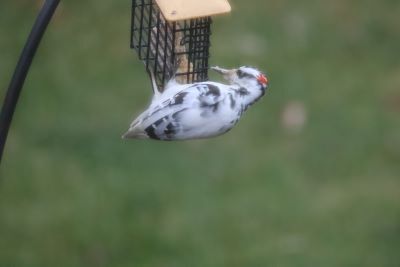
Good Natured: Color Conundrum in Birds
Last week when we took a look at the life and times of the hairy woodpecker, we described the species as predominantly black and white, with checkered wings and a white stripe on the back. Field guides add that the bill is nearly as long as the head, and males have red at the back of the head.
This description provides what you need to identify Dryobates villosus. Except when it doesn't.
The day I finished writing the hairy commentary, I received a note from friend and astute wildlife observer Leslie Martin. Lo and behold, it contained a couple of photos of a hairy woodpecker. This bird, however, looked decidedly different.
Leslie wrote, “At first I couldn't figure out what it was, but then a friend of mine contacted her bird guy. He knew it was a leucistic hairy woodpecker."
Whereas the typical hairy has black and white stripes on the side of its head, Leslie's bird is mostly white. And where a typical hairy has black wings checkered with white, Leslie's has large white blotches with only a hint of black showing through.
His overall look reminded me of the time I absentmindedly poured bleach into a washer load of dark clothing. My black t-shirt was never the same again. And like that shirt, Leslie's woodpecker won't ever display the colors normally associated with his species. But instead of Clorox, Leslie's woodpecker's appearance comes courtesy of some sort of internal interference.
Exactly what, though, will have to remain a mystery.
I really wanted to provide a concise, scientific explanation of what's going on with this bird's plumage, but after hours of combing over multiple references on birds and aberrant coloration, I do believe I'm more confused now than when I started. And a few pounds heavier too.
I'd better explain…
Sitting down for some quick research, I grabbed a dictionary and a few Hershey's Kisses. Peeling off the foil wrappers and chewing contentedly, I read that leucism is “an abnormal condition of reduced pigmentation affecting various animals…marked by overall pale color or patches of reduced coloring and is caused by a genetic mutation which inhibits melanin and other pigments from being deposited in feathers, hair, or skin."
I was almost ready to go with that, but thinking I should get a birder's perspective on the phenomenon I went to All About Birds, the trusted online source by Cornell University's Lab of Ornithology. I also made a sandwich and opened a bag of chips.
Cornell's page on color variations in birds states that leucism is “not a genetic mutation, but rather describes defects in pigment cells that are caused during development." The article also lists hypomelanism—a genetic condition that results in a lesser amount of the dark pigment melanin—as well as age and injury as other possible causes of paler-than-normal coloration.
These conditions were summarized beneath a larger heading, Partial Albinism. Now this was an interesting development! I distinctly remember learning, years ago, that albinism is an all-or-nothing condition. Either the melanin is there, or it's not.
Determined to get to the bottom of this color conundrum, I devoured several more articles--and a bag of Corn Nuts—that variously stated a) there's no such thing as partial albinism; an organism is either an albino, with a complete lack of melanin, or it's leucistic; b) leucism is too broadly defined to be helpful and c) partial amelanism, a localized lack of melanin, is the preferred term.
(I also stumbled onto an online debate as to the correct pronunciation of leucism. Some folks say LEW-sism, others LUKE-ism. The latter justify their position by pointing out that the word comes from the Greek leukos, which means white.)
I was just about to throw in the towel when I found out I'm not in this sea of color confusion. In September 2021 the Bulletin of British Ornithologists' Club published “What's in a name? Nomenclature for colour aberrations," a 25-page (and four chocolate-chip cookie) dissertation complete with references and photos written by Hein van Grouw, senior curator of birds at The Natural History Museum in London.
He's been studying the topic for more than 30 years. Thirty years!! That's a lot of Corn Nuts, sandwiches, cookies and Kisses.
His conclusion? If you can't say for sure what caused the irregular coloring, avoid trying to name it. Carefully describe the bird and, if possible, take photos. It's the best and possibly only way to avoid misinterpretation that could result from using an incorrect term.
Today we can put a check by each of those recommendations. Thanks Leslie!
I'll add that along this journey I've learned that birds with unusual coloration occur at a rate of about 1 in 30,000; true albino birds usually struggle with vision issues, weakened plumage (melanin makes feathers stronger), and higher rates of predation; and birds with lesser amounts of odd pigmentation may or may not have these issues, depending on the degree of variance.
Leslie's woodpecker, you might have noticed, is missing his tail. Perhaps a close call with a predator?
I think I'll sit and ponder that possibility a bit longer. Right after I make some popcorn…
Pam Otto is the outreach ambassador for the St. Charles Park District. She can be reached at potto@stcparks.org.

